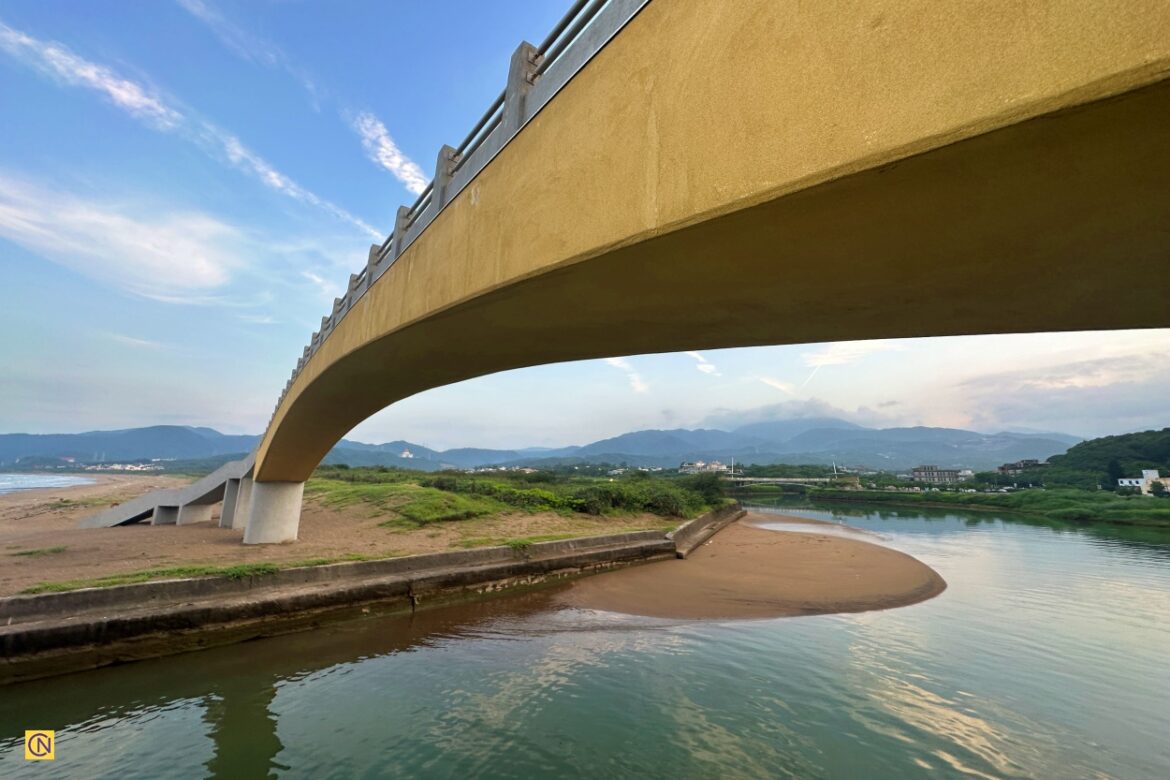New Taipei City’s Jinshan District, nestled along Taiwan’s northern coast, is home to spectacular hidden gems. Highlights include two scenic bridges, the historic Shuiwei Guangwu Tunnel, the striking Twin Candlestick Islets, the mysterious coastline, and the narrow One-Line Sky Crevice. Each spot offers a unique blend of natural beauty and historical charm, perfect for exploration and reflection.
For more interesting images, watch the following video, “Secrets of Jinshan’— A Journey Through Mysterious Tunnels, Trails, and Rocky Shores.”
The two signature bridges of Jinshan
Between Jinshan’s Shuiwei Fishing Harbor and Shuiwei Scenic Park stand two uniquely designed bridges — Shuiwei Fishing Harbor Scenic Bridge (水尾漁港景觀橋) and Yuantan Creek Scenic Bridge (員潭溪景觀橋) — facing each other just a five-minute walk apart. Together, they offer a scenic and peaceful route for visitors seeking visual beauty and quiet reflection.
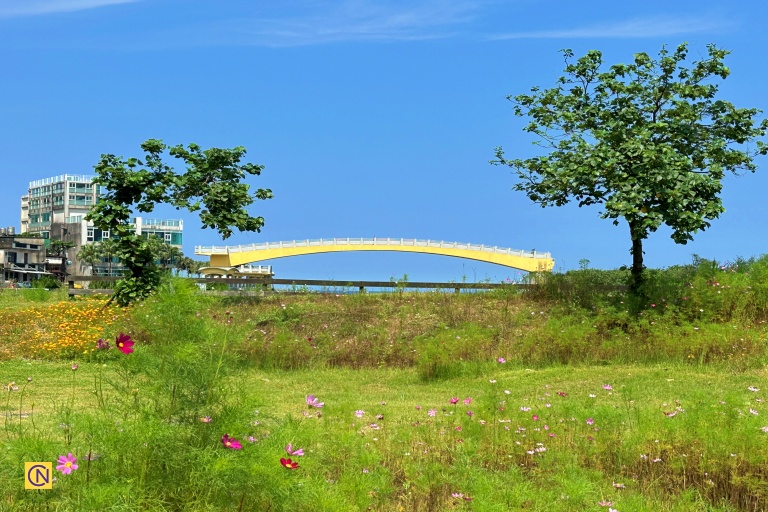
The Shuiwei Fishing Harbor Scenic Bridge, also known as the Jinbaoli River Bridge, was constructed in 2017. Its design is inspired by a fishing boat: The Wanli end represents the bow, and the flanking roadways form the wings. The imagery carries a symbolic meaning of “soaring toward success (鵬程萬里),” reflecting the hopes and ambitions of this historic fishing village.

The Yuantan Creek Scenic Bridge, spanning the river mouth of Yuantan Creek, features a graceful arch design. It was given a cheerful makeover in August 2022, repainted in a vibrant pastel yellow, making it one of the area’s visual highlights. The bridge is a fantastic spot to catch the sunrise or enjoy sweeping ocean views and Yehliu Cape in the distance.
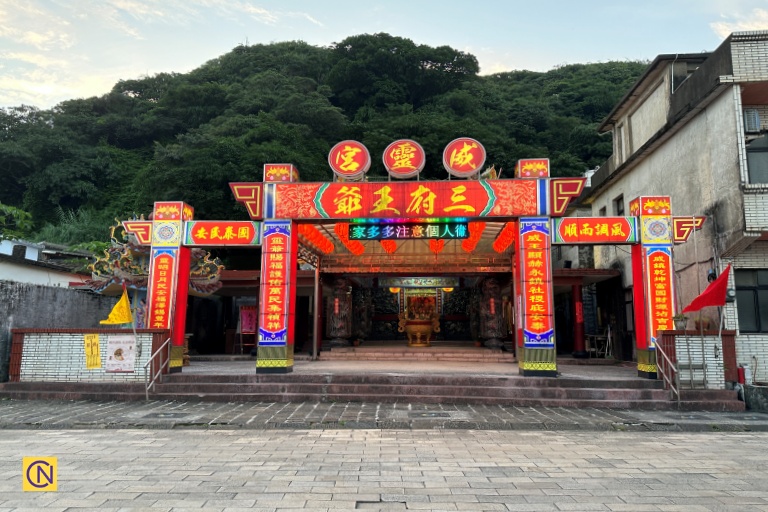
By day, these bridges provide a serene setting between the mountains and the sea. By night, the moonlight shimmering over the harbor creates the poetic scene known as “Moonlight over Shuiwei (水尾泛月),” one of the famed Eight Views of Jinshan — a timeless sight that continues to captivate all who pass by.
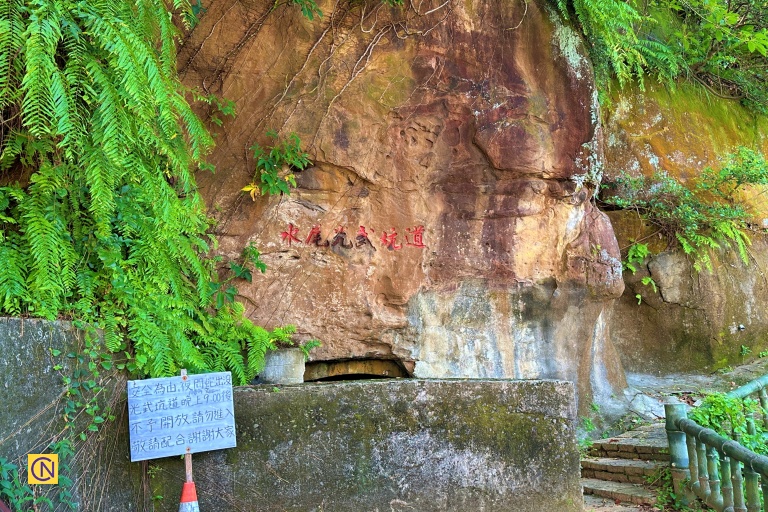
The Shuiwei Guangwu Tunnel in Jinshan
The Shuiwei Guangwu Tunnel lies tucked into the hillside behind Shuiwei’s Weiling Temple. Constructed during the Japanese colonial period, this concrete military tunnel stretches 361.5 meters in length. Its narrow interior is approximately 2 meters high and just 1 meter wide. The entrance is reached by climbing the equivalent of three flights of stairs.

The tunnel’s layout roughly forms an “I” shape, with a single entrance and exit, each featuring two zigzag-shaped concrete walls. Short horizontal passages run parallel to the mountainside along both ends, linking to several machine gun bunkers — each equipped with only a small firing hole pointing outward.
Visitors are advised to bring flashlights, as the tunnel is pitch dark inside. The confined space often requires people to hold hands to navigate safely. The damp air, echoing silence, and occasional fluttering of bats create an eerie, unforgettable atmosphere. Walking through the tunnel feels like stepping into a forgotten chapter of history, where one can trace the physical and emotional remnants of a turbulent wartime era.
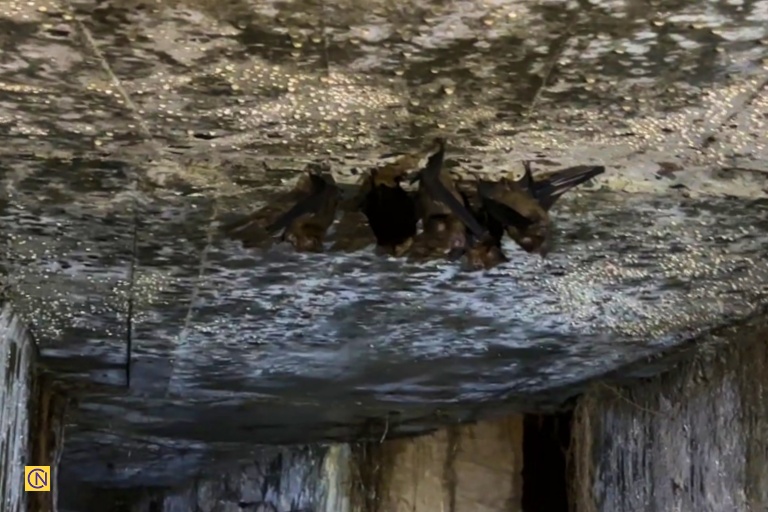
Twin Candlestick Islets in Jinshan
The Twin Candlestick Islets (雙燭臺) are two iconic pillar-shaped rock formations located about 450 meters off Jinshan Cape in Shitoushan Park (獅頭山公園), rising 60 meters above sea level. Resembling a pair of candlesticks emerging from the sea, they are among the most striking landmarks along Taiwan’s north coast.
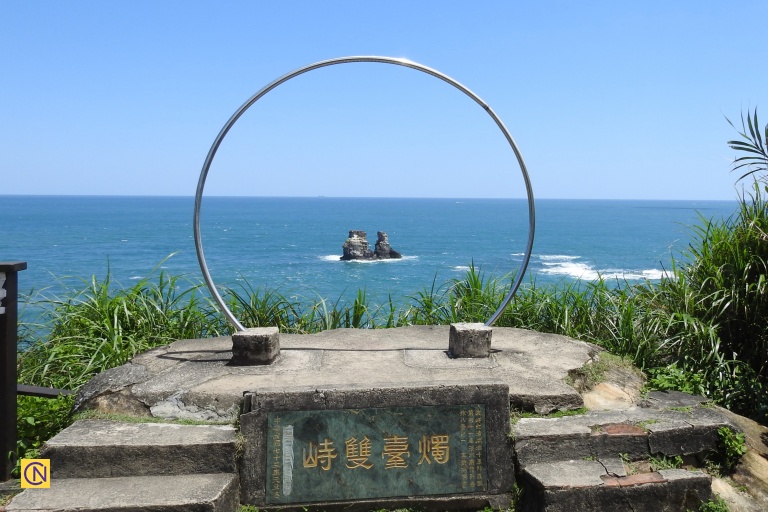
A local legend gives them a romantic backstory: A woman in Jinshan waited daily for her fisherman husband’s return. After waiting in vain for years, she turned into stone. When her husband finally came back and discovered her fate, he was devastated and wept beside the rock until he too became stone. Locals also refer to them as the Husband and Wife Rocks, symbolizing eternal love and devotion.
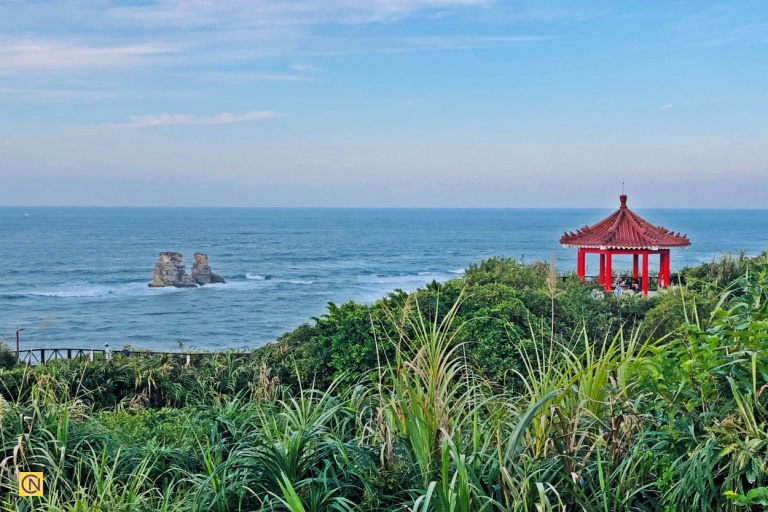
Their dramatic form and symbolic meaning earned them a place among the Eight Scenic Wonders of Northern Tamsui, as recorded in Qing Dynasty chronicles. Today, they remain a beloved natural and cultural landmark of Jinshan.
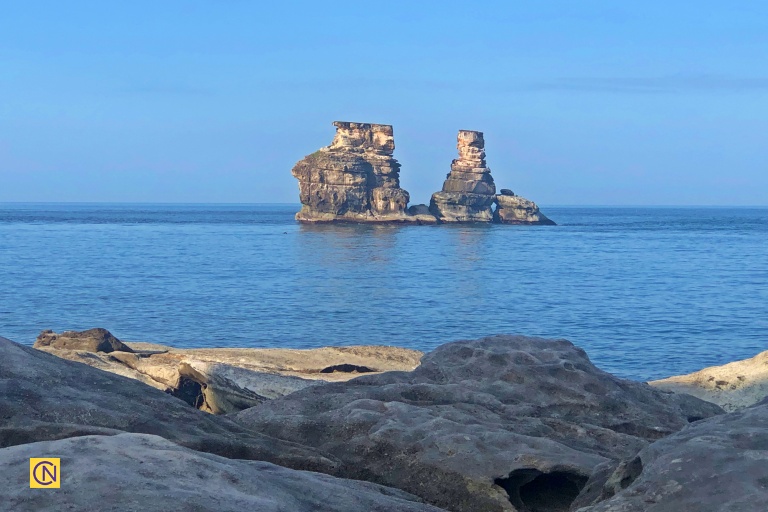
The Mysterious Coast in Jinshan
Tucked between Shuiwei Fishing Port and the Twin Candlestick Islets lies the Mysterious Coast — a rugged, wave-sculpted shoreline shaped by dramatic sea erosion. Stretching nearly 400 meters (1,312 ft), this hidden shore was closed to the public for about 50 years before reopening two decades ago.
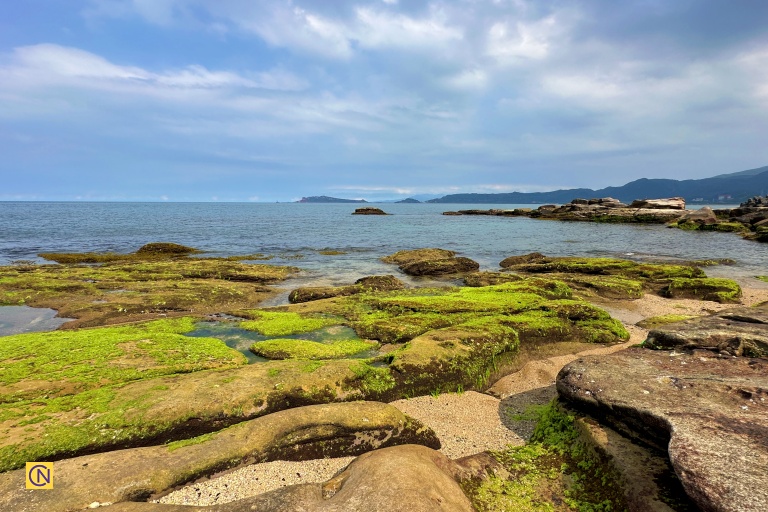
Visitors climb wooden stairs near Shuiwei Fishing Port and squeeze through a narrow vertical crevice between the rocks to reach it. Once through, a breathtaking coastal landscape unfolds — towering cliffs, crashing waves, and various striking rock formations in orange-brown hues, some of which are covered with green algae, creating a surreal and colorful scene.
The Mysterious Coast gained wider recognition after director Martin Scorsese chose it as a filming location for his 2016 Oscar-nominated film Silence (沉默). Since then, it has become a favorite spot for those seeking natural beauty, cinematic atmosphere, and a sense of discovery along Taiwan’s north coast.
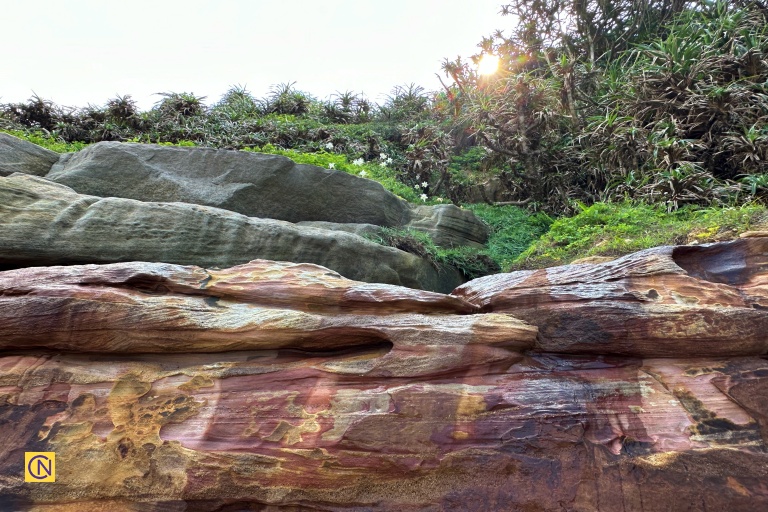
One-Line Sky Crevice in Jinshan
The Thread of Sky, known as “One-Line Sky” (一線天), is a stunning natural rock formation in Jinshan, New Taipei City, Taiwan. This unique geological feature is characterized by a narrow crevice between towering cliffs, creating a breathtaking view that resembles a single line of sky. Visitors often hike through the surrounding trails to experience the dramatic scenery, which is particularly captivating during sunrise and sunset. The area is a popular spot for photography and offers a serene escape into nature, making it a must-visit destination for locals and tourists.

In a world filled with constant motion and digital noise, this quiet stretch of Taiwan’s northern coast offers visitors a chance to pause, breathe, and reconnect with the present moment. Whether you’re drawn by history, inspired by nature, or simply seeking a deeper travel experience, Jinshan’s hidden gems promise a meaningful and unforgettable journey.
Follow us on X, Facebook, or Pinterest

